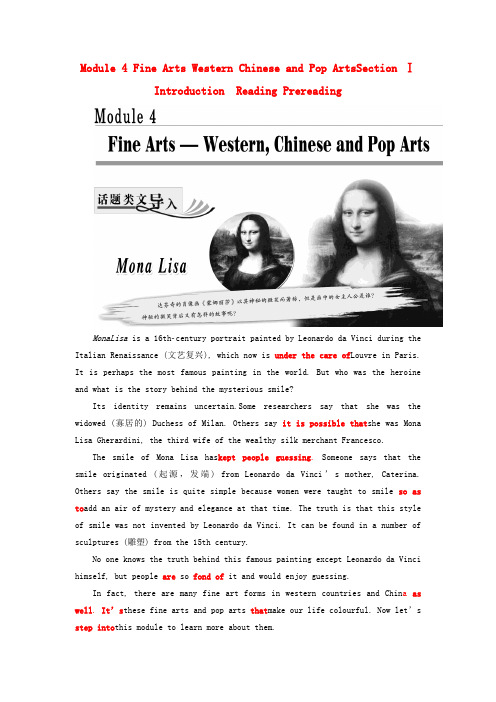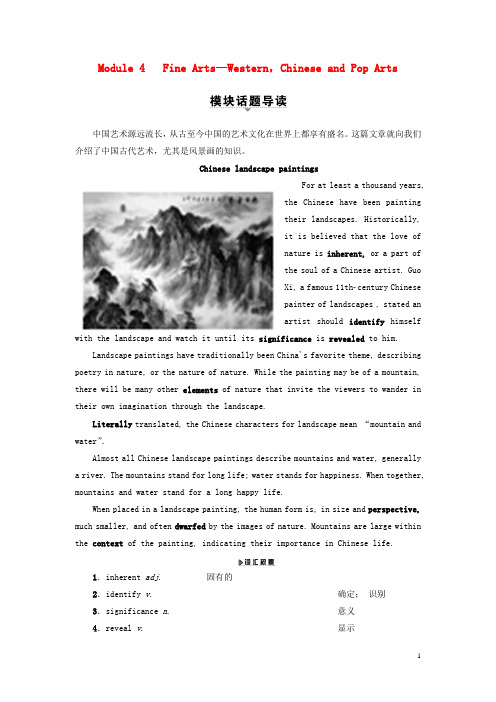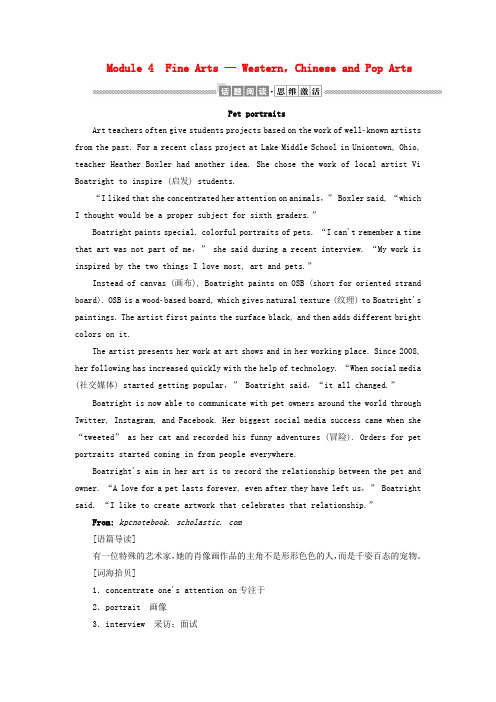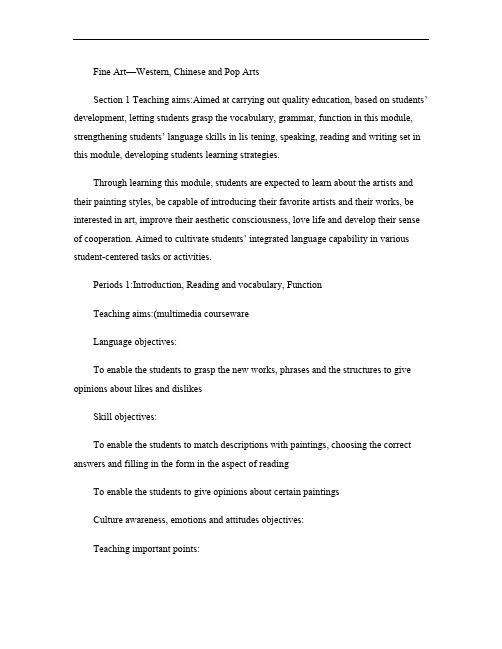高中英语 Module 4 Fine ArtsWestern, Chinese and Pop Arts Task writing课件 外研版必修2
- 格式:ppt
- 大小:337.01 KB
- 文档页数:12

FineArts —WesternChineseandPopArts-readingAims:1.2.Step1.RevisionDictationforwordsandexpressions:Step2.Matchthesewordsandphraseswiththedefinitions.A.alive wayinwhichsomethingisdoneB.aspect watchcarefullyC.imatatestyleofpaintingadoptedbyagroupo fartistD.movement copyE.observe orfulloflifeF.ordinary specialorunusualG.reality oftheseparatepartsofsomethingH.style waysomethingrealityisStep3.Matchpaintings1-4withdescriptionsinparagraphsA-D 〔见课本32页图〕Saywhichpaintingsarementionedinparag raphsE()andF().Step4.ReadparagraphsA-Fagainandchoosethecorrectanswer.(见课本34页)Step5.SummaryFillintheblanksaccordingtothetextHerearesomepaintingsbyfamousartistsfromhomeandabroad. OneisbyPicasso,________ ___tobethegreatestartistofthe20th century,withwhomanotherpainter,Braque,_____cubism,oneofthemodernartistspainted objectsandpeople_______differentaspectsoftheobjectsorperson________atthesametime.ThepaintingbyRoyisafamousexampleof____________ ,which___________showordinary20th-centurycitylife.Theother2areQiBaishiandXuBeihong.Chinesepainting_________________itsbrushdrawingsinblackink sandnatural________theworldofnature________andhispaintingsarespecial____________this.Xubelievedthatartistsshould____________butnotjustimitateit.________,apictureshouldtryto________________ofitssubject.LanguagePointsThisisapaintingbytheSpanishartist,PabloPicasso,consideredtobethegreatestwesternartistofthetwentiethcentury.翻译:______________________________________________________________________________ _____consider(1)vt.&vi.considerdoing(考虑做某事);consider+where(wh开头的疑问词)+todosth(考虑什么时候/去哪里做某事)①我学校很多学生在考去国外学。

Module 4 Fine Arts Western Chinese and Pop ArtsSection ⅠIntroduction Reading PrereadingMonaLisa is a 16thcentury portrait painted by Leonardo da Vinci during the Italian Renaissance (文艺复兴), which now is under the care of Louvre in Paris. It is perhaps the most famous painting in the world. But who was the heroine and what is the story behind the mysterious smile?Its identity remains uncertain.Some researchers say that she was the widowed (寡居的) Duchess of Milan. Others say it is possible that she was Mona Lisa Gherardini, the third wife of the wealthy silk merchant Francesco.The smile of Mona Lisa has kept people guessing. Someone says that the smile originated (起源,发端) from Leonardo da Vinci’s mother, Caterina. Others say the smile is quite simple because women were taught to smile so as to add an air of mystery and elegance at that time. The truth is that this style of smile was not invented by Leonardo da Vinci. It can be found in a number of sculptures (雕塑) from the 15th century.No one knows the truth behind this famous painting except Leonardo da Vinci himself, but people are so fond of it and would enjoy guessing.In fact, there are many fine art forms in western countries and Chin a as well. It’s these fine arts and pop arts that make our life colourful. Now let’s step into this module to learn more about them.Section_ⅠIntroduction & Reading —Prereading[原文呈现][读文清障]AThis is a painting①by the Spanish artist②, Pablo Picasso, considered to be the greatest western artist of the twentieth century③. Picasso and another painter④,George Braque, started Cubism, one of the most important of all modern art movements⑤. Cubist artists painted objects and people, with different aspects of the object or person showing⑥ at the same time⑦.BThis painting by contemporary⑧American artist Roy Lichtenstein(1923-1997) is a world famous example of pop art⑨. Pop art(from the word “popular”) was an important modern art movement that aimed⑩to show ordinary⑪twentiethcent ury city life. For example, it shows things such as⑫soup cans⑬ and advertisements.CQi Baishi(1863-1957), one of China’s greatest painters, followed⑭the traditional⑮Chinese style⑯of painting. Chinese painting is known for⑰its brush drawings⑱in black inks⑲and natural⑳colours. Qi Baishi①painting/’peIntIŋ/n.绘画;油画②artist/’aːtIst/n.艺术家③considered ...为过去分词短语作后置定语。

Module 4 Fine Arts—Western,Chinese and Pop Arts中国艺术源远流长,从古至今中国的艺术文化在世界上都享有盛名。
这篇文章就向我们介绍了中国古代艺术,尤其是风景画的知识。
Chinese landscape paintingsFor at least a thousand years,the Chinese have been paintingtheir landscapes. Historically,it is believed that the love ofnature is inherent, or a part ofthe soul of a Chinese artist. GuoXi, a famous 11thcentury Chinesepainter of landscapes , stated anartist should identify himself with the landscape and watch it until its significance is revealed to him.Landscape paintings have traditionally been China's favorite theme, describing poetry in nature, or the nature of nature. While the painting may be of a mountain, there will be many other elements of nature that invite the viewers to wander in their own imagination through the landscape.Literally translated, the Chinese characters for landscape mean “mountain and water”.Almost all Chinese landscape paintings describe mountains and water, generally a river. The mountains stand for long life; water stands for happiness. When together, mountains and water stand for a long happy life.When placed in a landscape painting, the human form is, in size and perspective, much smaller, and often dwarfed by the images of nature. Mountains are large within the context of the painting, indicating their importance in Chinese life.1.inherent adj. 固有的2.identify v. 确定;识别3.significance n. 意义4.reveal v. 显示5.element n. 元素6.literally adv. 从字面意思7.perspective n. 远景8.dwarf v. 变小9.context n. 背景1.What do landscape paintings describe?2.What do mountains and water together stand for in Chinese landscape paintings?【答案】 ndscape paintings describe poetry in nature,or the nature of nature.2.Mountains and water together stand for a long happy life.Section ⅠIntroduction & Reading and Vocabulary-Preparing根据提示写出下列单词1.n.爱好;嗜好2.n. 憎恶;不喜欢3.n. 艺术家4.adj. 彩色的5.adj. 当代的6.adj. 令人愉快的;可爱的7.n. 景色;风景8.adj. 传统的;习俗的9.adj. 有活力的;有生气的10.n. 方面11.vt. 临摹;仿造;模仿;仿效12.vt. 观察;注意到13. n. 真实;现实;逼真14. n. 风格15. vt. 采纳;采用16. vi. 以……为目标;打算;意欲17. vt. 忍受18. adj. 不寻常的;非凡的【答案】 1.like 2.dislike 3.artist 4.colourful 5.contemporary 6.delightful 7.scene8.traditional 9.alive 10.aspect 11.imitate12.observe 13.reality 14.style 15.adopt16.aim 17.stand 18.unusual看单词学构词:ful为常见的形容词后缀。

Module 4 Fine Arts — Western,Chinese and Pop ArtsPet portraitsArt teachers often give students projects based on the work of wellknown artists from the past. For a recent class project at Lake Middle School in Uniontown, Ohio, teacher Heather Boxler had another idea. She chose the work of local artist Vi Boatright to inspire (启发) students.“I liked that she concentrated her attention on animals,” Boxler said, “which I thought would be a proper subject for sixt h graders.”Boatright paints special, colorful portraits of pets. “I can't remember a time that art was not part of me,” she said during a recent interview. “My work is inspired by the two things I love most, art and pets.”Instead of canvas (画布), Boatright paints on OSB (short for oriented strand board). OSB is a woodbased board, which gives natural texture (纹理) to Boatright's paintings. The artist first paints the surface black, and then adds different bright colors on it.The artist presents her work at art shows and in her working place. Since 2008, her following has increased quickly with the help of technology. “When social media (社交媒体) started getting popular,” Boatright said,“it all changed.”Boatright is now able to communicate with pet owners around the world through Twitter, Instagram, and Facebook. Her biggest social media success came when she “tweeted” as her cat and recorded his funny adventures (冒险). Orders for pet portraits started coming in from people everywhere.Boatright's aim in her art is to record the relationship between the pet and owner. “A love for a pet lasts forever, even after they have left us,” Boatright said. “I like to create artwork that celebrates that relationship.”From: kpcnotebook. scholastic. com[语篇导读]有一位特殊的艺术家,她的肖像画作品的主角不是形形色色的人,而是千姿百态的宠物。

Module 4 Fine Arts---Western, Chinese and Pop ArtsI.教学内容分析本模块以“Fine Arts”为话题,介绍了毕加索等数位著名的艺术家及其艺术风格,同时引入了与艺术和艺术欣赏相关的词汇。
教师通过模块教学,让学生了解这些艺术家及其艺术风格,并能用英语简单介绍自己喜爱的艺术家和他们的艺术作品,从而提高学生的艺术欣赏能力,培养学生的文化意识和语言表达能力。
Introduction部分开始通过三个问题引起学生的兴趣,与此同时引入一些与艺术有关的词汇,再通过一个口头练习来让学生初步掌握这些词汇的意义,为以后的学习做好准备。
Reading and V ocabulary部分分为两个部分,第一部分是词汇,通过词义配对,培养学生的英语思维能力,初步清除阅读时的词汇障碍;第二部分是阅读理解,先让学生看四幅画,通过这四幅画引出该篇文章。
该文章由六个段落组成,前面四个段落分别介绍了四位非常出名的艺术家,后两个段落是两个中学生对这四幅画的评论和看法。
围绕课文,编者设计了三个练习。
通过练习,学生可以熟悉课文内容,学会使用与艺术有关的词汇。
Function部分列出了交际中常见的表达意见的语句,要求学生就自己喜欢的和不喜欢的艺术作品发表自己的看法,使学生掌握这些交际用语。
Grammar J部分通过让学生观察例句,从中发现动词的-ing和to do形式做宾语的区别。
要求学生通过一系列的练习来学习并掌握动词的.ing形式和to do形式做宾语的语法功能,并能正确地使用该语法项目。
Listening and V ocabulary部分有两个主要任务,一是词汇,通过完成句子的形式来让学生了解该部分词汇的含义,为听力活动做好铺垫;二是听录音,然后完成与录音内容相关的练习。
Grammar 2部分通过观察句子,了解动名词形式作主语的现象。
要求学生学会使用动名词作主语这一语法规则。
Speaking部分要求学生相互提问,通过一问一答的方式来练习表达“喜欢”与“不喜欢”。

Fine Art—Western, Chinese and Pop ArtsSection 1 Teaching aims:Aimed at carrying out quality education, based on students’ development, letting students grasp the vocabulary, grammar, function in this module, strengthening students’ language skills in lis tening, speaking, reading and writing set in this module, developing students learning strategies.Through learning this module, students are expected to learn about the artists and their painting styles, be capable of introducing their favorite artists and their works, be interested in art, improve their aesthetic consciousness, love life and develop their sense of cooperation. Aimed to cultivate students’ integrated language capability in various student-centered tasks or activities.Periods 1:Introduction, Reading and vocabulary, FunctionTeaching aims:(multimedia coursewareLanguage objectives:To enable the students to grasp the new works, phrases and the structures to give opinions about likes and dislikesSkill objectives:To enable the students to match descriptions with paintings, choosing the correct answers and filling in the form in the aspect of readingTo enable the students to give opinions about certain paintingsCulture awareness, emotions and attitudes objectives:Teaching important points:To enable the students to speak out opinions about some paintings with some expressionsTo enable the students to grasp the new works and phrases in this partTeaching procedures: PWP Teaching ModelStep1. leading-in activityUse the paintings The Smile of Mona Lisa by da Vinci and the works by Zheng Banqiao on the screen to lead in the topic. Meanwhile, I will introduce the key new words: artist, paint, traditional, brush, ink.Step 2. While—reading1ScanningDuring the start of the period, let the students scan the passage to find out the answers to the questions on Page32, which are about the topics.⑴Match paintings 1-4 with descriptions in paragraphs A-D.⑵Say which paintings are mentioned in paragraph E and F.2Detailed readingDuring this period, I’ll allow students enough time to read the text and then I let them work in groups to do the following two tasks:⑴Do the multiple choices on the screen.⑵Fill in the form on the screen, which is mainly about the famous artists.3Language points⑴consider 认为.⑵with复合结构⑶aim 以…为目标;意欲;打算⑷stand 忍受⑸I got bored of looking at pictures all the time.⑹Tom gradually became interested in art.Step3. Post—readingDuring this period, I’ll let the students do the following tasks.⑴Find out the structures that can be used to giving opinions about likes and dislikes from the paragraphs E and F individually.⑵And then, along with the students, I’ll look through the sentences giving opinions, provided in the first part of Function, making sure that they know how to express likes and dislikes. Show the students a series of paintings on the screen, letting them in groups talk about the pictures they like and dislike, and why or why not, using the information learned from the reading material(or in the form of interviewing—group work.Step4. HomeworkTry to find more paintings and artists you like through the Internet.Prepare to introduce a painting in English to your classmates next class.(The day students are assigned to the first task; and the rest of the students to the second.Blackboard design:Module 4 Fine arts—Western, Chinese and Pop Arts Period Oneconsider: consider sb./sth. to be adj./n.with复合结构: with+宾语+宾补(adj./adv./prep. Phrase/-ing/-ed/inf.aim v./n. aim to do sth. aim at doing sth.stand+n./doing sth.get tired of/get bored of “厌烦……”develop an interest in“养成对……的兴趣”Teaching reflection:In the process of leading in, students are familiar with the paintings and the artists, so the pictures can easily arouse their interest and desire to participate. In the process of while-reading, pay attention to the developing of students reading strategies. In the process dealing with language points, setting the new words in a context helps the students learn and comprehend the meaning and the usage of them. In the discussion about their favorite paintings, some students are reluctant to speak, partly because of their lack of knowledge of painting; most students can communicate with their partners or group members after learning the reading materials. The task of assignment is set for the sake of the second period, that is, Listening and vocabulary, to some extent.。
闪堕市安歇阳光实验学校高考英语 Module4 Fine Arts Western,Chinese and Pop Arts总复习作业本外研版必修2Ⅰ.单项填空1.The expert advised the boy,who always fails to remember the new words,to________an effective way of learning vocabulary.A.admire B.designC.adopt D.invent2.It is usually warm in my hometown in March,but it________be rather cold sometimes.A.must B.canC.should D.would3.If you’re free at two o’clock on Friday,I shall be________to show you around the city.A.delightful B.delightedC.stressful D.stressed4.The student didn’t observe the teacher________the experiment carefully,so he didn’t give the right answer.A.to perform B.performC.to be performing D.having performed5.She threatened to take the magazine to________court if they didn’t publish________ immediate apology.A./;the B.the;/C./;an D.the;an6.—You’re an excellent teacher.—________I’m glad you like the class.A.Thanks for the compliment! B.You’ve got it right.C.I’m not half as good as you.D.What do you make of it?7.What made me happy was that the suggestion I put forward at the meeting was________ immediately.A.adopted B.abandonedC.agreed D.applied8.I recognised her at the first sight,although we________each other for about twenty years.A.didn’t see B.haven’t seenC.hadn’t seen D.don’t see9.________the key,the boy couldn’t enter his house.He could do nothing but wait.A.Lost B.LosingC.To lose D.Having lost10.Mothers were sitting on a bench chatting,with theirchildren________beside them.A.playing B.to playC.played D.having played11.—Are you fond________painting?—No,I’m tired________it,but my mother forces me to do it.A.of;from B.of;ofC.at;from D.at;of12.The energy Jenny Bowen has devoted in the past tenyears________the orphans has been considered________of great value.A.to help;being B.to helping;to beC.to help;to be D.helping;being13.I could________by the way she walked that her knee was still bothering her.A.tell B.separateC.divide D.find14.—Most of the apples in the bag have gone bad.—Yes,only three are good.The rest________gone rotten.Just now I ate part of a big one,and the rest________thrown away.A.has;was B.have;wereC.have;was D.has;were15.The organization’s aims________food for homeless people and help them find somewhere to live.A.are to provide B.to provideC.of providing D.are providingⅡ.完形填空(2011·皖南八校第二次联考)When someone has deeply hurt you,it can be extremely difficult to let go of your anger.But forgiveness is possible and it can be surprisingly__1__to your physical and__2__health.“People who forgive__3__less depression,anger and stress and more hopefulness,” says Frederic Luskin,Ph.D.,__4__of Forgive for Good.“So it can help __5__on the wear and tear on our organs,reduce the wearing out of the immune system and__6__people to feel more vital.”So how do you start the forgiveness?Try__7__these steps:Calm yourself.To defuse (缓和) your __8__and try a simplestressmanagement technique.“Take a couple of breaths and think of__9__that gives you pleasure:a__10__scene in nature,someone you love,” Luskin says.Don’t __11__an apology.“Many times the person who hurt you has no__12__of apologizing,” Luskin says.“They may have wanted to hurt you or they just don’t see things the same__13__.So if you wait for people to apologize,you could be waiting a(n)__14__long time.” Keep in mind that forgiveness does not necessarily mean__15__ to the person who upsets you. Take the control away from your offender.Mentally replayingyour__16__g ives power to the person who caused you pain.“__17__of focusing on your hurt feelings,learn to look for the love,beauty and kindness__18__you,” Luskin says.Try to see things from the other person’s perspective (视角).If you empathize (有同感) with that person,you may__19__that he or she was acting out ignorance,fear even love.Recognize the benefits of forgiveness.Research has shown that people who forgive are reported more energy,better__20__and better sleep patterns.Don’t forget to forgive yourself.“For some people,forgiving themselves is the biggest challenge,” Luskin says.“But it can rob you of your selfconfidence if you don’t do it.”B.harmfulC.helpless D.suitable2.A.chemical B.wealthyC.technical D.mental3.A.own B.showC.direct D.prove4.A.author B.ownerC.professor D.publisher5.A.insist B.saveC.wait D.depend6.A.require B.wishC.invite D.allow7.A.forgiving B.turningC.following D.counting8.A.sadness B.angerC.hunger D.energy9.A.something B.anything C.nothing D.everything 10.A.thoughtful B.dull C.beautiful D.still 11.A.call for B.hunt for C.bid for D.wait for 12.A.invention B.invitation C.intention D.attention 13.A.way B.means C.method D.approach 14.A.helpfully B.carefully C.patiently D.awfully 15.A.giving in B.giving away C.giving up D.giving out 16.A.wound B.hurt C.cut D.damage 17.A.Because B.In honour C.Instead D.In search 18.A.around B.above C.beneath D.below19.A.forget B.realizeC.announce D.doubt20.A.housing B.salaryC.safetyⅢ.阅读理解(2011·南昌调研)Jamie Oliver has been invited by Gordon Brown to prepare a banquet at No.10 Daming Street for President Barack Obama and other leaders of the G20,offering a cutprice menu to reflect times when trade and industry are far from prosperous and the rate of employment is decreasing.Downing Street sources say Oliver,the wellknown chef,will cook using “honest highstreet products” and avoid expensive or “fancy” ingredients.The prime minister is trying to avoid a repeat of the embarrassment la st year when he sat down to an 18course banquet at a Japanese summit to discuss world food shortages.Obama,President Nicolas Sarkozy of France,Chancellor Angela Merkelof Germany and other leaders will be served by apprentices (学徒) from Fifteen,the London restaurant Oliver founded to help train young people in poverty in order to make a living by mastering a skill.Brown wants the dinner to reflect the emphasis of the London summit,which he hopes will lead to an agreement to lift the world out of recession.“To be invited to cook for such an important group of people,who are trying to solve some of the world’s major problems,is really a privilege,” said Oliver.“I’m hoping the menu I’m working on will show British food and produce is some of the best in the world,but also show we have pioneered a highquality apprentice scheme at Fifteen London that is giving young people a skill to be proud of.”The chef has not yet finalized the menu,but is expected to draw inspiration from his latest book,Jamie’s Ministry of Food,which has budget recipes for beef and ale stew (啤酒炖菜) and “impressive” chocolate fudge cake.1.The underlined word “recession” in Paragraph 5 is closest in meaning to “________”.A.business B.opposition C.discussion D.depression2.What can we learn about Oliver from the text?A.He is a wellknown American cook.B.He is invited to attend the G20 summit.C.He has founded Fifteen London.D.He is one of the apprentices serving the leaders of the G20. 3.Which of the following is TRUE according to the text? A.Oliver is honored to be invited to cook for the G20 leaders. B.Altogether three presidents are mentioned in the text. C.President Barack Obama offers the cutprice menu.D.The menu for the G20 dinner banquet has been decided. 4.What is Fifteen London?A.An apartment in London.B.A luxurious restaurant in London.C.A restaurant as well as a training center.D.A famous avenue.答案Ⅰ.单项填空1.解析:adopt采用,采取,采纳,符合题意。
高一英语Module 4 Fine Arts—Western, Chinese and Pop Arts外研社【本讲教育信息】一. 教学内容:Module 4 Fine Arts—Western, Chinese and Pop Arts二. 重难点讲解1. adopt v.采用,采纳;We adopted their methods to produce.We can’t give birth, so we adopt a child.2. object v.反对 n.目标;物体;宾语;对象;He objects to the plan.翻译:他反对被当成小孩子对待。
I could see a shinning object in the sky.A sentence must have a subject, not necessarily object.His object in life is to serve the country.3. observe v. 看,观察,注意到;She observes attentively.I observed a letter on the table.译:我注意到有几个学生睡着了。
同根词:observer4. like prep. 像 v. 喜欢He looks like an athlete.I like swimming.alike a.相像的 likely a.有可能的 prefer v. 喜欢love v.热爱 enjoy vt. 喜欢 appreciate v.欣赏be fond of 喜欢 be into sth. 喜欢5. imitate v. 模仿,效仿You should imitate great and good men.Parrots often imitate human speech.You’ve made a good imitation.6. stand v.忍受I can’t stand a lot of noise when I’m reading.当我读书时,忍受不了那么大的噪音。